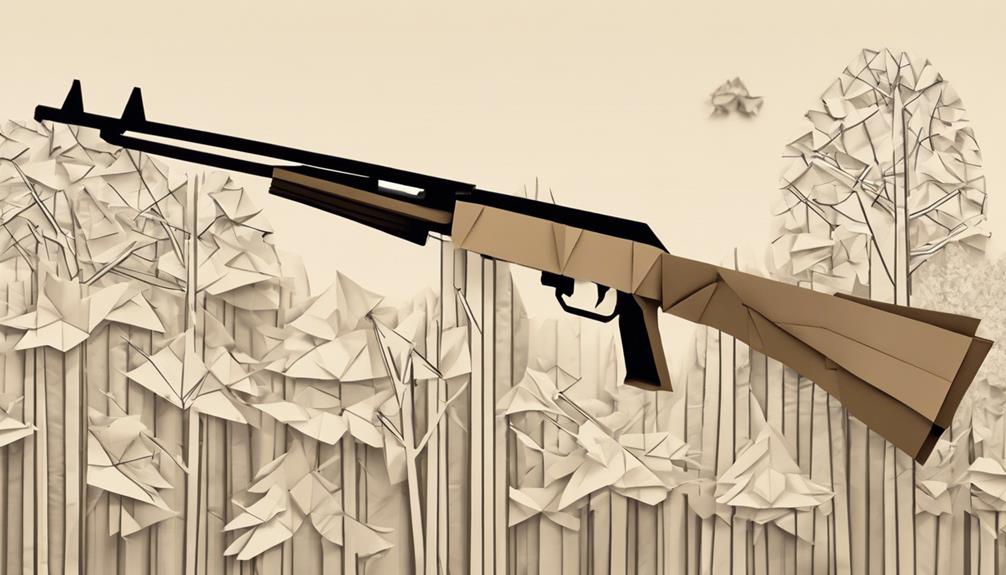General Rules of Field Target
As you step into the world of field target shooting, you'll need to familiarize yourself with the general rules. To begin with, rifles are limited to .22 caliber and 12 ft-lbs of power, with barrel lengths ranging from 12 to 24 inches. You'll need to exhibit good conduct and sportsmanship throughout the competition. Courses are carefully designed with varied terrain and target placement to challenge your skills. Mastering different shooting positions, from prone to standing, is essential for success. Now that you've got a glimpse into the world of field target, explore further to uncover the intricacies of this precision shooting sport.
Rifle Specifications and Restrictions

When competing in field target, you'll typically find that rifles are restricted to a maximum caliber of .22 and a maximum power output of 12 ft-lbs. This guarantees a level playing field for all participants and promotes a focus on marksmanship skills rather than raw power. You'll also need to weigh up barrel length, which can range from 12 to 24 inches, depending on your personal preference and shooting style.
In terms of caliber options, you're not limited to just .22, but you'll need to verify that your rifle meets the maximum power output restriction. Some popular caliber options include .177 and .20, which offer a good balance between accuracy and power. When choosing a caliber, ponder factors like your shooting distance, target size, and the type of ammunition you plan to use. By understanding these specifications and restrictions, you'll be well on your way to competing effectively in field target competitions.
Shooter Conduct and Sportsmanship
As you step onto the field target course, you're expected to embody the highest standards of sportsmanship, respecting fellow competitors, and adhering to a strict code of conduct that guarantees a positive and enjoyable experience for all participants.
You'll be expected to uphold etiquette expectations, such as not distracting or disrupting other shooters during their shots, keeping noise levels down, and avoiding any behavior that could be deemed unsportsmanlike. Respecting opponents is essential, so refrain from criticizing or offering unsolicited advice to fellow competitors.
Remember, field target is a sport that values camaraderie and respect. You're encouraged to offer support and encouragement to your fellow shooters, and celebrate their successes as you would your own. By doing so, you'll contribute to a positive and uplifting atmosphere that benefits everyone involved.
As you compete, keep in mind that you're not only representing yourself, but also the sport as a whole. By conducting yourself with integrity, respect, and sportsmanship, you'll help foster a community that's welcoming, inclusive, and enjoyable for all.
Course Design and Layout

Now that you're familiar with the importance of sportsmanship on the field target course, you'll need to understand how the course itself is designed to challenge and engage you. A well-designed course is essential to a fun and competitive shooting experience. Course designers strategically place targets and obstacles to test your skills and push you to improve. You'll encounter course obstacles like tunnels, walls, and barricades that require you to adapt your shooting stance and technique. Landscaping challenges like hills, valleys, and uneven terrain will also put your abilities to the test. The course layout is carefully planned to provide a varied and exciting experience, with targets placed at different distances, angles, and elevations. As you navigate the course, you'll need to think strategically and make quick decisions to overcome the challenges that lie ahead. By understanding the course design and layout, you'll be better equipped to tackle the obstacles and come out on top.
Target Types and Placement
You'll encounter several types of targets on a field target course, each designed to test your marksmanship skills in unique ways. The variety of targets is intentional, as it simulates real-world hunting scenarios where you'll face unpredictable situations. This target variability keeps you on your toes, forcing you to adapt quickly to different distances, angles, and sizes.
Some common target types you'll encounter:
- Paper targets: These are the most common type, featuring a circular or rectangular shape with a scoring zone.
- 3D targets: Life-like models of animals, these targets require you to take into account pellet trajectory and wind resistance.
- Kneeling targets: Designed to test your shooting skills from a kneeling position, these targets often feature a smaller kill zone.
- Reaction targets: These targets fall or move when hit, simulating the thrill of hunting live game.
When placing targets, course designers bear in mind the environmental impact of the course. They choose locations that minimize the course's footprint, preserving the natural habitat and ensuring a sustainable shooting environment. As you navigate the course, remember to respect the land and the targets, taking pride in your shooting skills while promoting a culture of responsibility.
Shooting Positions and Styles

In field target shooting, mastering various shooting positions and styles is vital, since each one demands a unique set of skills and techniques. You'll need to develop proficiency in different positions to tackle various scenarios on the course. Prone mastery, for instance, is vital for those tricky, low-lying targets. To excel in this position, you'll need to perfect your body alignment, breathing, and trigger control.
When it comes to standing techniques, you'll need to focus on balance, posture, and stability. You'll want to develop a consistent stance, with your feet shoulder-width apart and your body weight evenly distributed. Pay attention to your breathing and try to relax your shoulders and arms. Standing techniques require more upper body strength and control, so you must build up your endurance and precision.
Scoring Systems and Penalties
As you step into the world of field target, you'll need to understand the scoring systems that govern the sport. You'll encounter two main methods: the hit or miss system, where a target is either hit or not, and more complex scoring methods that award points based on the target's distance and size. You'll want to familiarize yourself with these systems to maximize your scores and stay competitive.
Scoring Methods
Your score in a field target competition depends on the scoring system used, which can vary between tournaments but often involves a combination of points and penalties. As a competitor, understanding the scoring method used in each tournament is imperative to maximize your chances of winning.
Some key aspects of scoring methods in field target competitions include:
- Score Verification: The accuracy of scores is paramount. Score verification processes are in place to prevent errors and maintain fairness.
- Digital Tracking: Many modern field target competitions use digital tracking systems to record and verify scores. These systems provide an efficient and accurate way to track scores in real-time.
- Penalty Systems: Penalties can be incurred for various infractions, such as shooting out of turn or failing to follow safety protocols. Comprehending the penalty system used in each tournament is necessary to maintaining a competitive edge.
- Scorekeeper Oversight: In some cases, a scorekeeper may review and verify scores to maintain accuracy and fairness.
Hit or Miss System
You'll encounter the hit or miss system in many field target competitions, where targets are either considered hit or missed, with no partial credit given. This system demands absolute target accuracy, as a single pellet hole outside the target's scoring zone is considered a miss. The scoring philosophy behind this system is simple: a hit is a hit, and a miss is a miss – there's no in-between.
As a competitor, you'll need to focus on precision and control to guarantee you hit your targets consistently. A single mistake can cost you the competition, making every shot count. This system encourages you to refine your skills, pushing you to be a better shooter.
The hit or miss system is a true test of your marksmanship skills, requiring you to be accurate and consistent. With no room for error, you'll need to be completely focused on your target, eliminating any distractions. By adopting this system, field target competitions promote a culture of excellence, where only the most skilled and dedicated shooters will rise to the top.
Penalty Zones
What happens when you hit a target but part of the pellet hole falls outside the scoring zone – do you get penalized, and if so, how? This is where penalty zones come into play. In field target, penalty zones are areas surrounding the target that incur deductions from your score if your pellet hole falls within them.
Zone boundaries, clearly defined areas surrounding the target, marked by distinct lines or colors, indicate the start of the penalty zone. Measurements are taken from the edge of the pellet hole to the nearest zone boundary, facilitating accurate scoring.
Penalty zone deductions are made according to the zone in which the pellet hole falls, with more severe penalties for holes falling in zones farther from the target center. Accurate measurements and clear zone boundaries facilitate fair and consistent scoring, vital for a level playing field in field target competitions.
Understanding penalty zones and their implications is vital for maximizing your scores and success in field target competitions.
Safety Precautions and Procedures

As you prepare to participate in a field target competition, prioritize safety above all else. You'll need to verify you're equipped with the right eye protection, and that you're aware of the Range Officer's guidance throughout the event. By following these critical safety precautions and procedures, you'll be able to focus on your shooting skills without compromising your well-being.
Eye Protection Essentials
When shooting field target, prioritize eye protection, since a single stray pellet can cause serious, even permanent, eye damage. You can't take your eyes for granted; they're your most valuable asset on the shooting range.
To maximize protection, consider the following crucial factors when choosing your eye protection gear:
- Lens coatings: Look for lenses with anti-fog and scratch-resistant coatings to guarantee clear vision and durability.
- Frame materials: Opt for frames made from durable, lightweight materials like polycarbonate or TR-90 for comfort and flexibility.
- Lens color: Choose lenses with a neutral color tint to minimize color distortion and ensure accurate target visibility.
- Frame style: Select frames with a wraparound design to provide additional protection from stray pellets.
Range Officer Guidance
Before you start shooting, make sure you understand and follow the range officer's guidance on safety precautions and procedures to minimize risks and maintain a safe shooting environment. The range officer is responsible for ensuring that all participants follow the safety rules and regulations. It's essential to respect their authority and instructions at all times.
When interacting with the range officer, practice good Officer Etiquette by being respectful, courteous, and attentive. If you have any questions or concerns, don't hesitate to ask. Effective Communication Strategies are crucial in preventing accidents and ensuring a smooth shooting experience.
Equipment Inspection and Approval
You'll need to verify your rifle and accessories meet the specified standards, as outlined in the official field target regulations, to pass the mandatory equipment inspection. This inspection is vital to guarantee a safe and fair competition for all participants. To avoid any issues, make sure to check your gear thoroughly before the event.
Some key aspects to focus on during your equipment maintenance:
- Rifle specifications: Confirm your rifle meets the caliber, power, and length requirements outlined in the regulations.
- Gear customization: Check that any modifications or customizations to your rifle or accessories comply with the rules.
- Accessory inspection: Verify that your scope, mounts, and other accessories meet the specified standards.
- Equipment maintenance: Regularly inspect and maintain your equipment to prevent any malfunctions or damage during the competition.
Dispute Resolution and Appeals

In the unlikely event of a dispute arising during the competition, it's essential that you understand the official procedures for resolving issues and filing appeals. You should be aware that the competition organizers will make every effort to resolve disputes promptly and fairly. If you're involved in a dispute, you'll be notified of the procedures and timelines for resolving the issue.
If you're unhappy with the outcome, you can appeal the decision. You'll need to submit your appeal in writing, stating the grounds for the appeal and any supporting evidence. The appeal will be reviewed through the Arbitration Process, which is designed to be impartial and transparent. In exceptional cases, a Judicial Review may be necessary to resolve the dispute. It's vital that you understand the appeal process and the timelines involved, so you can plan accordingly. Remember, the goal of the dispute resolution process is to maintain fairness and consistency in the competition. By understanding the procedures, you can focus on what matters most – enjoying the competition and showcasing your skills.
Frequently Asked Questions
Can I Use a Rifle With a Higher Magnification Scope?
"Want a competitive edge? You're tempted to crank up the magnification, but scope limitations can hinder your accuracy. Weigh the magnification advantage against the risk of obscured targets – freedom from restrictions starts with informed choices."
Are There Any Restrictions on Camouflage Clothing?
When it comes to camouflage clothing, you're free to choose your gear, but be aware that pattern limits and fabric rules might apply, so check the specific competition guidelines to verify you're not restricted.
Can I Bring My Pet to the Shooting Range?
"Imagine a zoo at the shooting range – chaos! As you prepare to fire, your pet's sudden bark startles you, and… well, let's just say it's not a good mix. Sorry, no pets allowed, not even emotional support animals, for safety's sake and good Pet Etiquette."
Can I Shoot With My Non-Dominant Eye?
You're wondering if you can shoot with your non-dominant eye? It's possible, but first, determine your eye dominance – you might be cross-dominant, meaning your non-dominant eye aligns with your dominant hand, making it doable with practice.
Are There Any Discounts for Junior Shooters?
As you take aim at the future, you'll be pleased to know that many clubs offer discounted Youth membership rates, and some even provide Family discounts, so you can share the thrill of shooting with loved ones.






